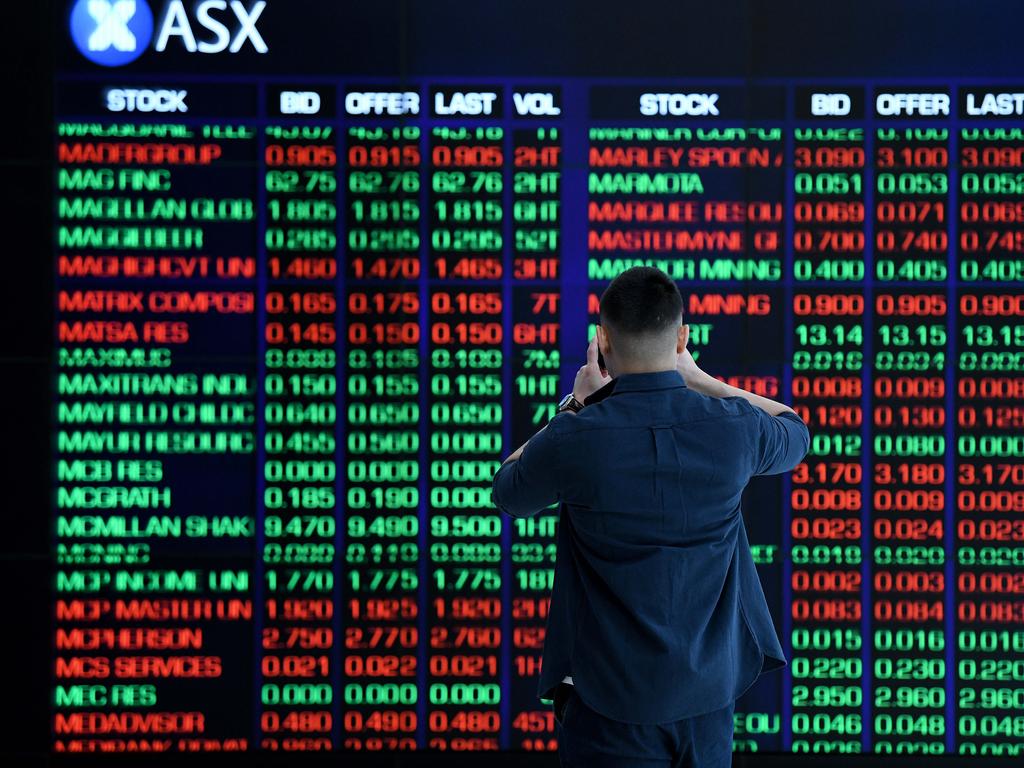Surging Australian stockmarket on track for record month
Australia’s benchmark ASX 200 share index on Monday closed up by an amazing 10.7 per cent for the month to date.

An exceptionally strong rise in shares this month comes as global markets look forward to a time when unprecedented fiscal and monetary policy stimulus get traction, as the world learns to live with coronavirus thanks to effective vaccines and strategies to limit its spread.
After hitting a nine-month high of 6594 points on Monday, Australia’s benchmark ASX 200 share index closed up 0.3 per cent at 6561.6, potentially signalling a short-term pullback. But it was still up by an amazing 10.7 per cent for the month to date.
If it ends November with a gain of more than April’s 8.8 per cent rise — it has risen 19 per cent since then — it will be the best month for the ASX 200 since inception in 2000.
The All Ords is up 10.42 per cent for the month-to-date, on track for its best since March 1988.
Notwithstanding the logistical difficulties of mass vaccination, high efficacy rates for the Pfizer-BioNtech and Moderna vaccines and high hopes from the phase three trial results of the Astra-Zeneca vaccine this week, as well as a watchful Federal Reserve, have led the market to be patient.
Still, the US economy will worsen before it gets better, as a messy US presidential transition delays fiscal stimulus, while COVID-19 infection rates are soaring, restrictions are increasing, Thanksgiving looms as a virus spreading event, and mass vaccination will be some way off.
With the VIX index of volatility in S&P 500 futures near its lowest levels since the pandemic began, the sharemarket may be near peak optimism, at least until COVID-19 is clearly under control and major new US stimulus is agreed to, with the Fed likely sidelined, barring a market sell-off.
Global equities are now vulnerable to month and quarter-end rebalancing of portfolios from equities to bonds in line with their mandates, says JPMorgan.
“We see some vulnerability in equity markets in the near term from balanced mutual funds, a $US7 trillion ($9.6 trillion) universe, having to sell around $US160bn of equities globally to revert to their target 60:40 allocation either by the end of November or by the end of December at the latest,” says JPM global market strategist, Nikolaos Panigirtzoglou.
Those funds include balanced mutual funds — like 60/40 portfolios — US defined-benefit pension plans and some big investors like Norges Bank, which manages Norway’s sovereign wealth fund, and the Japanese government pension plan GPIF.
A continuation of the equities rally into December is likely to give rise to an additional $150bn of selling into the end of December by pension fund entities that tend to rebalance on a quarterly basis, Panigirtzoglou says.
Macquarie’s Australian equity strategist Matthew Brooks is overall bullish although he does concede that there’s some downside risk for equities in 2021.
A potential concern for shares would be a sharp rise in bond yields that not only impacts specifically interest rate sensitive groups — like gold, bond proxies, and growth stocks — but also the overall market, since the 10-year bond yield is the so called “discount rate” that feeds into equity valuation models.
“It’s hard to judge when that tipping point will be crossed, but owning stocks that benefit from rising yields provides a hedge,” Brooks says. “Stocks may pull back after recent gains, especially given rising cases in the US and Europe, but with multiple effective vaccines, we think investors should be positioning for the end of the pandemic.”
But he argues that a greater risk would be a sustained fall in yields as this could cause financials and value stocks to underperform.
“This could occur if there were widespread shutdowns in the US, or the Fed or RBA targeted 10-year yields, but we think effective vaccines reduce the risk of both these events,” he says.
In any event he has told clients to position for higher bond yields in 2021.
On that basis, Macquarie Equities has added Westpac, ANZ, Suncorp, Computershare and NIB to its model portfolio, while removing Evolution and GPT Group and reducing Spark Infrastructure, City Chic Collective and James Hardie.
The view is that vaccines will reduce the need for more monetary easing, which should allow bond yields to “catch up with the cycle”. The concern is that yield spikes can be “short and sharp”, as in 2013, when 10-year yields rose 120 basis points over 10 months, and in 2016, when yields rose more than 80 basis points in eight weeks.
With the 10-year US yield now sitting just above its 200-day average, it’s “not impossible” that it could spike 50-100 basis points over the next six to nine months, Brooks cautions.
But in his view, equities should not fear the initial rise in bond yields as it will be driven by stronger growth, and the Reserve Bank’s $100bn of bond buying will help support share valuations.








To join the conversation, please log in. Don't have an account? Register
Join the conversation, you are commenting as Logout